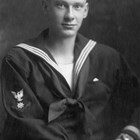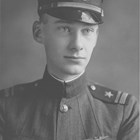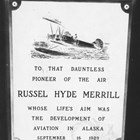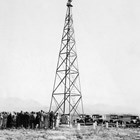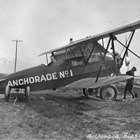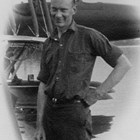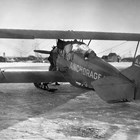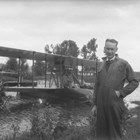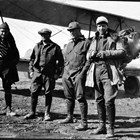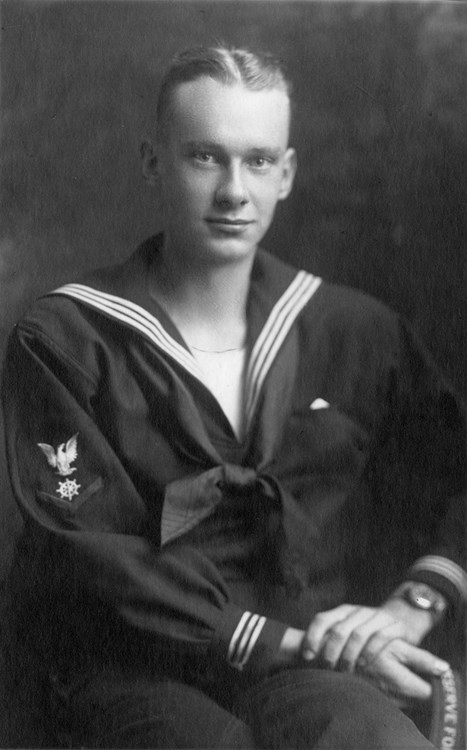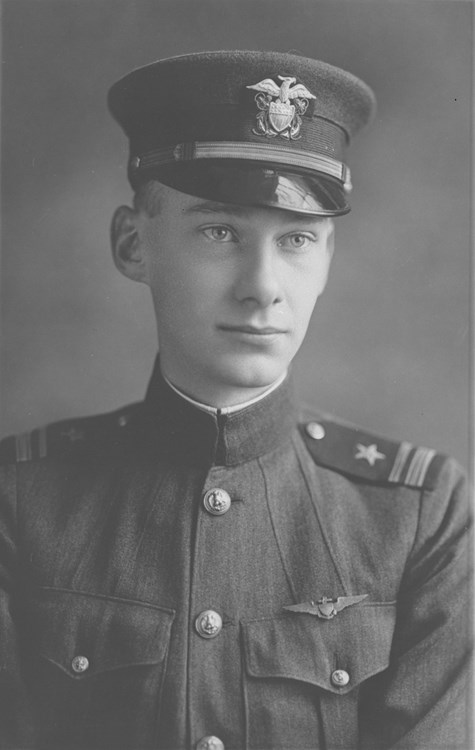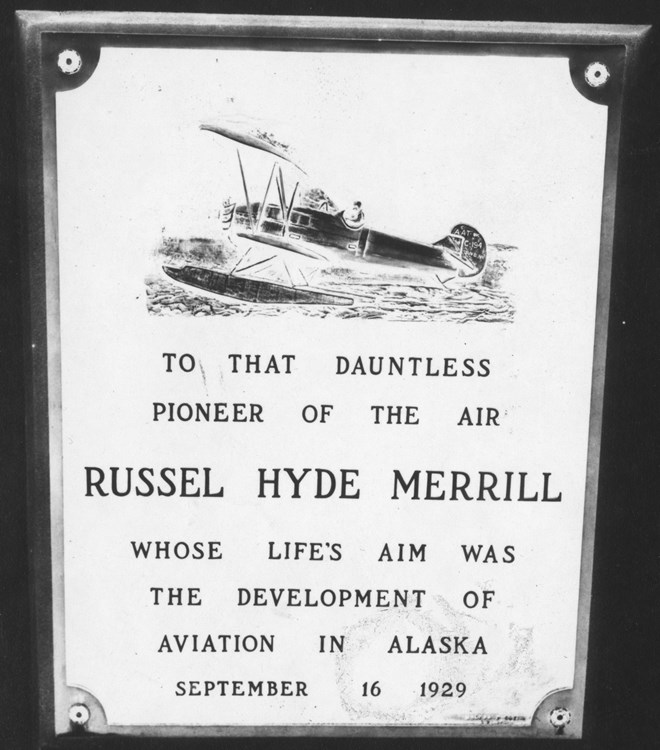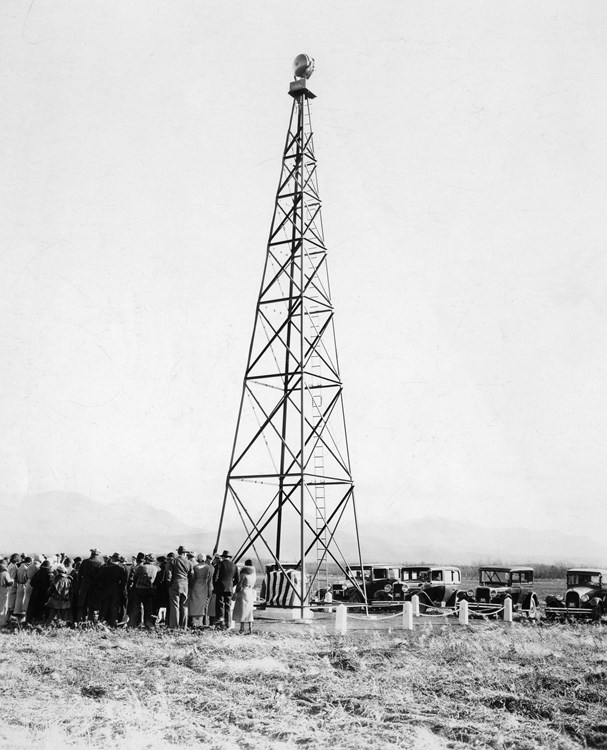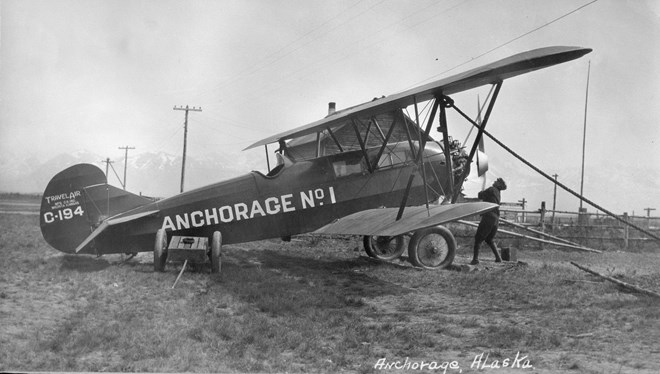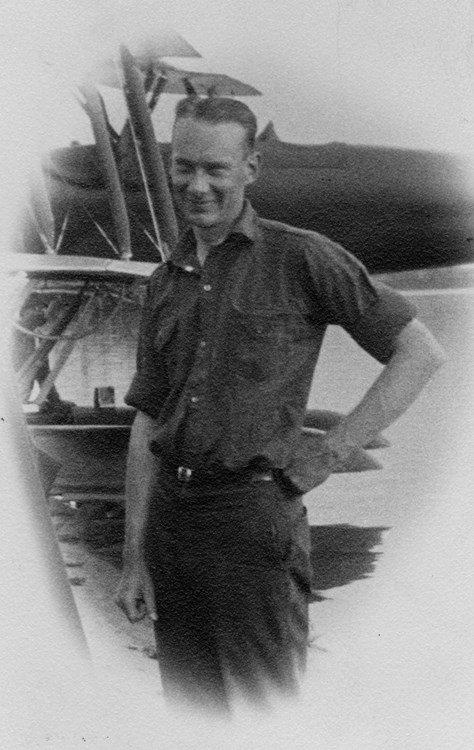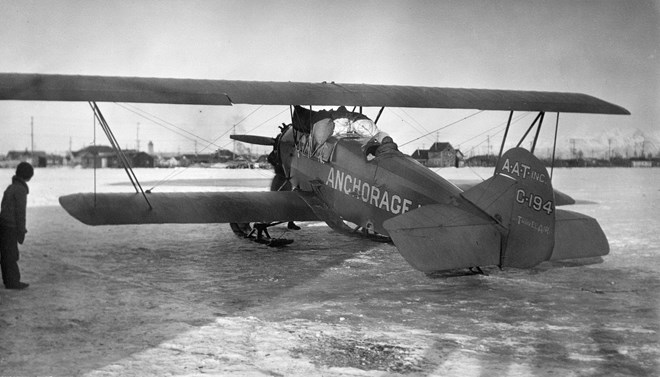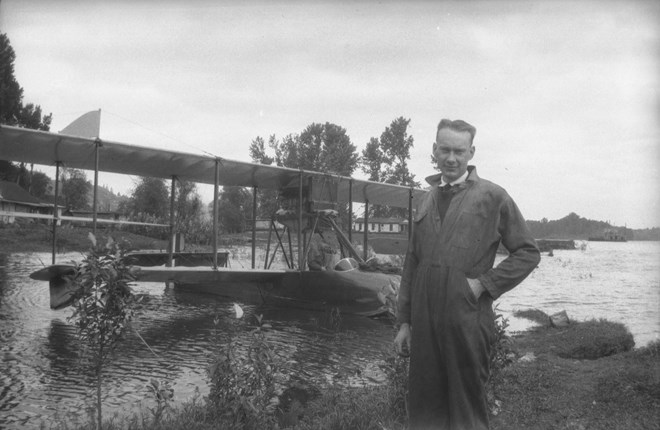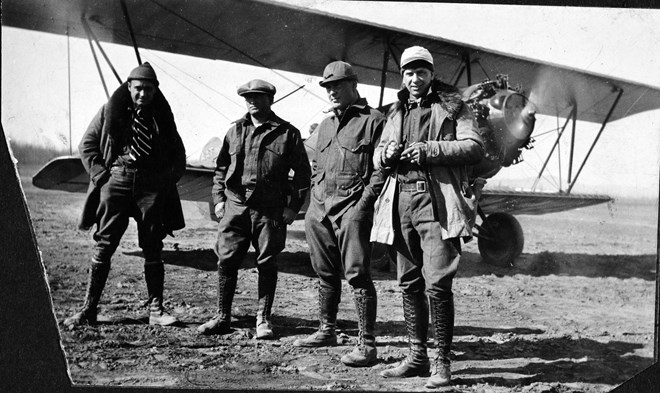Merrill, Russel Hyde
1894-1929 | Pioneer Aviator
Russel Merrill pioneered aviation in the Anchorage area before his airplane was lost over Cook Inlet in 1929. He was the chief pilot for Arthur A. "Art" or "A.A." Shonbeck, the power behind Anchorage Air Transport. He was credited by his contemporaries for being largely responsible for the development of Anchorage as an important air center, and for his work in the “promotion, extension and use of airplanes in this section of Alaska.”1 In 1925, his initial flight to Alaska in a Curtiss F Flying Boat, with Roy Davis, to Seward, was the first attempt by an airplane to cross the Gulf of Alaska. This flight was also the first commercial flight westward from Juneau. In 1927, Merrill became the first pilot to find a shorter, quicker air route through the Alaska Range to the Kuskokwim region through what was named Merrill Pass. That year, he also made one of the first night landings in Alaska.
Merrill left Anchorage on the afternoon of September 16, 1929, in a Travel Air CW (Anchorage No. 1), on a supply run to the New York-Alaska Company’s mine at Nyac in the Kuskokwim region when he was lost over Cook Inlet. The wreck was never found, but a piece of airplane fabric washed up on a beach at Tyonek, on the west side of Cook Inlet, and was identified by Alonzo Cope, the mechanic who had worked on the plane.
Early Life
Russel Hyde Merrill (1894-1929) was born April 8, 1894, in Des Moines, Iowa, the son of Samuel A. Merrill and Fannie Hyde Merrill. Russel’s first name was spelled with one “L.” He came from a well-to-do, socially prominent, family. The Merrills owned several farms and other property in the Des Moines area. He had two brothers, Edward and Jerry. His great-uncle, Samuel Merrill, was governor of Iowa from 1868 to 1872. His grandfather, Peter Ludlow Hyde, a Union officer in the Civil War, was killed at the Battle of Arkansas Post.2
Merrill went to public school in Des Moines, Iowa. He graduated from West Des Moines High School in 1912, where he was an all-around student and athlete. He was a member of the track team, social club, and played the flute in the school band. In September 1912, he entered Grinnell College, Iowa, where he completed his freshman, sophomore, and junior years before transferring to Cornell University, in September 1915, to study chemical engineering. He was attending Cornell University when the United States entered World War I in April 1917. On May 11, 1917, he enlisted in the U.S. Navy as a Seaman Second Class, in the U.S. Naval Reserve Force.3 He was one of two thousand students who left Cornell in April and May 1917, to join the Army, Navy, or engage in the “indispensable industries.”4
On May 12, 1917, Merrill reported for duty in Newport, Rhode Island for scout patrol duty. He served for a time in a sub-chaser squadron before applying for duty with the Naval Aviation Service. He was assigned to a naval aviation detachment at the Massachusetts Institute of Technology for ground school training, graduating among the top eight students. On January 19, 1918, he was sent to the Naval Air Station at Key West, Florida for flight training. There, he received rigorous flight training over water in Curtiss N9 seaplanes, which were float-equipped versions of the U.S. Army’s famous JN-4D Jenny. On March 12, 1918, he earned his gold wings as a naval aviator while stationed at Key West, becoming Naval Aviator No. 469. In April 1918, he was sent to Cape May, New Jersey, Naval Air Station, for advanced flight instruction. He was promoted to chief test pilot within several months. His duties included flight instruction and testing repaired airplanes, with the added responsibilities as a naval patrol pilot, conducting bombing and gunnery practice and searching for U-boats over the Barnegat and Atlantic City areas. Although Merrill never was sent overseas to Europe, by the end of the war in November 1918, he had been promoted to the rank of lieutenant (junior grade). On December 3, he was released from active duty.5
Merrill returned to Cornell University, where he received a Bachelor of Chemistry degree on October 1, 1919. He then took courses in marine piloting, navigation, and boat engineering in San Francisco. Although he wanted to enter aviation as a business, the postwar supply of pilots vastly exceeded the number of civilian jobs.
After graduation, Merrill joined the engineering department of Crown Willamette Paper Company at Camas, Washington in 1920 and part of 1921. There he met Thyra Allen, a secretary from nearby Portland, Oregon, and a long friendship started. In mid-1921, he was promoted to plant manager of the Crown Willamette Paper Company plant at Floristan, California. Earlier that year, Merrill’s father, Samuel, had died. He moved to Palo Alto, California to spend time with his mother, who had only twelve months to live. After she died, Merrill moved to Portland, Oregon, where he helped organize the Kern Clay Products Company, a building materials company, and become its general manager.6
In 1923, Merrill married Thyra Allen, the third of four children of Elmer O. Allen, the superintendent of schools in Portland, Oregon. There were two children—Robert Ludlow Merrill (born September 1924), later changed to Robert Merrill MacLean,7 and a step-son, Richard Kendrick Merrill, later changed to Richard Kendrick Wagner.8
Merrill retained a strong interest in aviation while he was advancing in the business world. He retained his pilot’s proficiency in both 1923 and 1924 by spending fifteen days with the Naval Reserve in San Diego. He again flew the N-9 primary trainer seaplanes as well as land-based JN-D4 Jennys as he had in 1918. He was introduced to the F5L, a multiengine type of flying boat with two Liberty engines. Both years, he flew mail for the U.S. Navy between San Diego and San Pedro.9
Flying in Alaska
On April 5, 1925, Merrill began his initial stint in Alaska when he responded to an advertisement from Roy J. Davis, a pioneer aviator and aero-mechanic, offering his plane, a modified Curtis Model F Flying Boat for sale in Portland, where he lived at the time. Davis told Merrill that he would not sell his plane if he could interest someone in starting an aviation business in Alaska. This started his career as a bush pilot. Merrill—along with Roy Davis, and Cyril Krugner—flew the Model F Flying Boat from Portland to Ketchikan, leaving on May 17 and arriving on May 25, 1925. Word of aviators Merrill and Davis spread quickly northward and they received invitations to fly to other southeast Alaska towns, Wrangell, Petersburg, and Juneau. Their mechanic—Krugner—returned to Portland as they no longer needed him. That summer, Merrill and Davis “barnstormed” in Alaska by flying tourists out of Ketchikan and Juneau. They went to outlying settlements and scouted salmon runs for area canneries. On August 1, with Roy Davis, he flew to Seward. It was the first attempt by a commercial airplane to cross the Gulf of Alaska and the first commercial air flight west from Juneau.10
In 1926, Merrill and Davis organized the Alaska-Washington Airplane Company, with Seward as headquarters. The two men gained the cooperation of several fish packing companies in Bristol Bay, including the Carlisle Packing Company. They hoped to operate a weekly Bristol Bay schedule, flying a zig-zag route out of Seward through the mountain passes to Bristol Bay, where they could service the canneries. Their route went through the Chugach Range to Lake Tustumena on the Kenai Peninsula, down the Kusilof (later Kasilof) River to Cook Inlet and on to Seldovia. From there, they planned to cross the water to Illiamna Bay, go through a pass to Lake Illiamna, and down the Kvichak River to Koggiung on Bristol Bay. On May 21, 1926, Merrill took the Curtis Oriole, in which he and Davis planned to fly to Alaska, on a test flight out on the Willamette River. He hit a submerged log, causing the plane to crash, badly damaging it. He and Davis bought another float plane, a three-passenger Aeromarine 40 Flying Boat, reaching Ketchikan on July 6 after experiencing motor trouble enroute. After experiencing delays in replacing the engine, the season was too far advanced and salmon packing operations in Bristol Bay closed on July 23. By the end of the summer season, the pair decided to dissolve their partnership, with Merrill keeping the plane in Ketchikan.11
Before he left Ketchikan for the Pacific Northwest, Merrill met Alonzo Cope, who represented a group of Anchorage business and professional men who, on December 29, 1926, established Anchorage Air Transport, Inc., the first local airline company in Anchorage. Alonzo Cope was Anchorage Air Transport’s mechanic and was charged with locating two planes for the new company. The directors of the new company were Arthur A. Shonbeck, Oscar Anderson, Gus Gilles, Will Clayson, and Dr. C.A. Pollard. The board elected Shonbeck as president and general manager. He was the Anchorage dealer for Ford automobiles and Caterpillar heavy equipment and was a miner and farmer. Russel Merrill became the first pilot. G.E. “Ed” Young, veteran Fairbanks airman, was the second pilot to be hired by Anchorage Air Transport, Inc.12
In February 1927, Russel and Thyra and the two boys sailed north to Seward, probably coming to Anchorage by train. The company bought two biplanes, a Travel Air Model CW that became Anchorage No. 1, and the Travel Air Model BW, Anchorage No. 2.13 The Anchorage No. 1 biplane had an open cockpit for the pilot and a closed cabin that could hold up to four passengers. The smaller Anchorage No. 2 biplane had two open cockpits, the rear one for the pilot, with the front cockpit carried two passengers, side-by-side. Both planes were powered by 200-horsepower Whirlwind radial engines. Only four of the Travel Air Model CW were ever built. The planes could be fitted with skis, pontoons, or wheels, depending on the landing terrain. Anchorage Air Transport took care to have the most modern and best equipped planes, almost regardless of cost. At the time they were purchased, the two planes were the best commercial aircraft in Alaska. In 1926, the year-old Travel Air Manufacturing Company, established by Clyde Cessna, Walter Beech, and Lloyd Stearman, was on its way of becoming the world’s largest producer of commercial aircraft.14
On arrival in Anchorage, the two biplanes were taken to Oscar Gill’s garage to be uncrated and assembled. A Travel Air factory representative took the first plane assembled up from the city’s Park Strip airfield, and flipped the plane when it landed, causing minor damage. The second plane also suffered damage when pilot G.E. “Ed” Young took it on its first flight to the Kuskokwim. On March 19, 1927, Merrill took off with the other plane, mounted on skis, struck a piece of ice on the runway, with parts of it being caught in the propeller, shattering the blades and damaging one of the wings.15
Open cockpits in Alaska meant flying in the cold. Pilots like Merrill wore long sheepskin coats, heavy mitts, leather helmets, goggles, and boots or Native-made fur mukluks.16 Some pilots wore Eskimo reindeer fur parkas. Only a small windshield protected them from the harsh blasts of the airstream. The air-cooled Whirlwind radial engine mounted in the two Travel Air biplanes was the latest word in power plant technology, but was new to Alaska and difficult to start and warm up in extreme weather. To help start the engine, a canvas shroud was hung over and around the motor and an oil stove was ignited under the engine. This technique became the time-honored method of starting air cooled radial engines in the far north.17
In April 1927, Anchorage Air Transport was asked by the U.S. Board of Education in Seattle to send an airplane to Savoonga, a village on St. Lawrence Island in the Bering Sea, to bring the severely ill president of the Native cooperative store to either a hospital in Nome or Fairbanks for urgent medical treatment. Merrill and Cope got as far as Nome, where they learned the sick man had died. Casting around for other business, Merrill picked up some passengers going to Candle, and took off on April 5, 1927. Shortly after leaving Nome they encountered severe weather and crashed on landing. Merrill chopped off the plane’s wings to make a shelter for the men to ride out the storm, which lasted another day and a half. The plane was later salvaged, rebuilt, and continued to fly.18 Although the humanitarian flight to Saint Lawrence had not worked out, it showed that the route from Anchorage to Nome was feasible, and Anchorage Air Transport decided to offer that service. It also received a contract to carry mail between Anchorage, Fairbanks and Nome.19
In August 1927, Merrill received a contract from the Alaska Road Commission and made repeated flights to map out and begin to establish small landing fields at Eklutna Lake, Tustumena Lake, Seldovia, Seward, Moose Creek, Cache Creek, Curry, Susitna, and the Skwentna River. During the latter part of the summer Merrill flew a variety of passengers around the area: trophy hunters to hunting camps, trappers to their trap lines, and sightseers eager to experience flying.20
On November 8, 1927, Merrill discovered the pass that was later to be named for him. The pass was a direct, low-elevation, shorter, quicker route across the Alaska Range to the Kuskokwim region. Flights could be made in one day, whereas, previously, it had taken two days to fly around through Rainy Pass. This pass (located almost due west of Anchorage) with a floor of 3,000 feet, was a boon to aircraft at the time, as they lacked accurate altimeters, with no instrument flying capability.21
Only a few weeks later, On November 20, 1927, Merrill made the first night landing on the Anchorage field. It was learned that a schoolteacher at Ninilchik had accidently shot herself and was in serious condition. Merrill was in Fairbanks with the company’s only operating airplane. Company president Arthur A. Shonbeck instructed Merrill to return and pick up the women and get her to the hospital in Anchorage. Accompanied by a Dr. A.D. Haverstock, Merrill made the flight to pick up his passenger. On attempting to take off, Merrill took his ski equipped airplane through some overflow on the lake, coating the bottom of the skis with six inches of ice. Merrill laboriously chipped off the ice, took off and arrived at Anchorage in the dark. Alonzo Cope heard the plane overhead and rushed to put out landing flares, and Merrill made one of the first night landings in Alaska. The next day Merrill fell ill with the chicken pox.22 In a letter to his brother Jerry, Merrill described this as “a pretty tough trip,” focusing his letter on landing after dark.23 After recuperating, Merrill continued flying passengers, particularly trappers and fur buyers, with their gear or pelts, around the region. The schoolteacher recovered.
In January 1928, Merrill tested the limits of his airplane by hauling the heaviest load of furs ever brought to Anchorage by airplane, 537 pounds of pelts from the lower Kuskokwim River, consigned by traders at Bethel for the Seattle Fur Exchange. There were twenty-two sacks of pelts aboard, evenly balanced with bagged furs stored in the forward, or passenger cockpit, with the remainder lashed in the upper portion of the fuselage and the wing, almost totally obstructing Merrill’s vision.24
Weather was a constant problem for early flyers in Alaska. Merrill and other early pilots repeatedly had to cancel or abort flights when they encountered bad weather because they did not know what weather conditions would be along their routes. On other occasions, poor weather led to damaged airplanes that would often have to be patched together on-site, taking planes out of service for days or weeks. Pilots were often grounded, sometimes for days, by storms or fog. Remote destinations often did not have radios so pilots could not learn weather conditions or report to their home base if they were grounded. As a business model, early aviation in Alaska left a lot to be desired. But there were distinct advantages. When planes could fly, flying paid well: the cost of a passenger flight from Anchorage to Bethel in 1927 was $300. Freight to Bethel was $1 per pound.25 On December 8, 1927, Merrill took trapper Alex Liska and all his gear to the foothills around Peters Creek, north of Anchorage. The flight took about an hour; it could have taken Liska an estimated ten days to accomplish the same distance by dogsled. Anchorage Air Transport had by early 1928 paid off most of its debt. In late winter 1927 and early spring of 1928, it had one month where it took in $8,000 with an overhead of only $2,000.26
Fox Film Expedition of 1928
Anchorage Air Transport agreed that Merrill, with Anchorage No. 1, would work with Noel Wien to transport a film crew from the Fox Film Expedition to Barrow, as the fee offered would provide a healthy surplus in its bank account. Starting from Fairbanks on May 12, 1928, Merrill and Noel Wien in two planes were flying a three-man film crew and their gear to Barrow. On May 13th, after crossing the Brooks Range, they were forced down by a fog that obliterated most landmarks approximately 150 miles from Barrow. There were no accurate maps of the landscape between the mountains and the coast, as existing maps usually showed numerous lakes and ponds on the tundra rather than exact locations of geographical features. Merrill and Wien were using wheels instead of skis or pontoons, because they expected to land on ice at Barrow. Merrill’s narrower tires bogged down in the snowy inland landscape. Wien had larger balloon tires, and after lightening his plane’s load, took off the next day with one of the film crew and arrived in Barrow. He then turned around and began searching for Merrill’s party and plane but bad weather grounded him for six days. Once Wien was able to fly, he was again forced down by low clouds obscuring the landscape, and was grounded, this time for four days. In Anchorage, none of this was known since the radio equipment in Barrow could receive, but not transmit, messages. It was now two weeks since Wien had left Merrill and two members of the Fox film crew. While waiting for rescue, these men had unsuccessfully attempted to clear or tamp down the snow to create a better runway. On May 22, the two-person film crew, Jack Robertson and Charles Clarke, decided to walk the 130 miles to Barrow. Merrill decided to stay “with the ship.” Merrill gave the two men most of the remaining food, keeping a small amount of rice. Later he exulted when he found a donut in the tail of the plane. Two days after the film crew walked away, Merrill tried taking off again and bent his propeller. He then decided to walk out, carrying some cooked rice. In his log, which he left with the plane, he wrote: “hope I can reach Barrow or a native home but rather doubt whether I can.”27
Pilot Matt Nieminen flew Anchorage Air Transport’s second airplane to Barrow, the open cockpit Travel Air Model BW, Anchorage No. 2, to assist with finding the lost film crew members of the Fox Film Expedition. On June 1, 1928, Robertson and Clarke were found fifty miles from Barrow, exhausted and starving and barely able to continue after hiking for ten days. One man supposedly had lost thirty pounds, the other forty, during their ordeal. One had frozen toes; the other had damaged the tendons in his legs and could walk only with the support of the other man. On June 4, the snow-blind Merrill, who had run out of food except for some raw lemmings he had shot with a .22-caliber pistol, and some old whale meat he found in a cache, was found by trapper John Hegness lying in the snow, forty miles from Barrow. He was taken by dog team to the hospital there, where he was treated for snow blindness, malnutrition, and exhaustion. After running a high fever, possibly from eating almost certainly diseased lemmings or rotten whale meat, his conditioned worsened and it was decided to send him south, by plane, to Fairbanks, where he was immediately taken to the hospital, on July 21, where his wife Thyra joined him.28 His condition was finally diagnosed as tularemia (Rocky Mountain spotted fever).29 Wien flew Merrill’s plane back to Anchorage for him. The whole project took over two months, and it was October before Merrill could fly again. Wien received an engraved watch from the citizens of Anchorage in recognition of his determined efforts to locate Merrill.30 In Barrow, Robertson and Clarke recovered from their ordeal and were released after a week in the hospital. By the end of July, the whaling season was over and the snow was melting. Clarke decided to return to California. Robertson made plans to go to Wainwright to help Fox director Ewing Scott film whales.31
In spite of the frequent problems with early flight in Alaska, Merrill felt that the economics were encouraging. In 1928, he explored the possibility of buying out Arthur A. Shonbeck’s share of Anchorage Air Transport.32 He hoped to arrange financing through his brother, Jerry, an Oregon banker and lawyer. On February 27, 1929, he wrote to Jerry: "Better sell out and come up here. I could get enough backing to buy a ship and we could start our own operating company. We probably wouldn’t make a fortune but nobody ever heard of anyone starving to death in Alaska! Our company cleared over $4,000 last year after all expenses including heavy depreciation, $2,000 for bringing me and my ship back from Barrow, and a bill of $1,800 for repair of some of our motors."33
Merrill’s Last Flight, September 16-17, 1929
On August 20, 1929, Arthur A. Shonbeck and the officers of Anchorage Air Transport sold their business to Alaskan Airways, Incorporated (later, Alaska Airlines). Merrill continued as pilot with the new company, flying out of Anchorage. Alaskan Airways had officially taken over operations of most of the independently operated enterprises, including Anchorage Air Transport, Wien Alaska Airways, and Bennett-Rodebaugh Company. The resulting transfer meant that it had obtained control of all aerial companies operating in Alaska north of Juneau.34
On September 16, 1929, Merrill had already flown two previous round trips, from Anchorage to Tustumena Lake and Rainy Pass. Already having worked a full day, he took off at 4:00 p.m. for a third flight to Akiak, near Bethel, taking a piece of needed machinery for the New York-Alaska Company’s mine at Nyac, on Bear Creek, a tributary of the Kuskokwim River. He also had about fifty pounds of first-class mail to deliver to various points along the route. Late in the evening a heavy storm struck Cook Inlet, and continued for several hours. It is unknown what happened, but Merrill never reached his destination. Search parties scoured the areas where Merrill might have been. A report of an object seen on Cook Inlet near Tyonek that might have been wreckage on the morning of September 17 was discounted.
The air and ground search continued into mid-October 1929. Such famed northern aviators as Colonel Carl Ben Eielson, Joe Crosson, H.A. Barnhill, and Frank Dorbrandt logged more than ten thousand miles in two weeks without finding a trace of Merrill or his airplane. On October 20, the owner of a fish trap site at Tyonek arrived in Anchorage with a piece of badly torn fabric, about twelve by forty inches in size that he had found on the beach on October 3. Alonzo Cope, the mechanic for Merrill’s plane, recognized it as part of a patch on the Merrill’s plane’s fabric covering that he himself had installed.35 The speculation was that, for whatever reason, the airplane had been forced down in Cook Inlet, and it was further damaged in the storm that came up during the night of September 16-17, with Merrill dying as a result. Merrill’s body was never found.36 One of the searchers, Ben Eielson, disappeared himself on a flight toward Siberia shortly thereafter, on November 9, 1929.
Legacy
In 1930, the Anchorage Woman’s Club raised funds for a permanent memorial to Russel Merrill in the form of a light beacon mounted on a steel tower at the Municipal Airport to serve as an aid in landing at the new airfield. In the summer of 1930, at the suggestion of the Anchorage Woman’s Club and the Anchorage Municipal Airport was renamed Merrill Field Airport in honor of Russel Merrill.37 On September 25, 1932, the new high intensity revolving beacon, resting atop a forty-six foot steel tower, was formally dedicated at Merrill Field. It was the first aircraft beacon in the Territory of Alaska. A bronze plaque, showing Merrill in the cockpit of Anchorage No. 1, was mounted on the face of the concrete base. The bronze table is inscribed: "To that dauntless pioneer of the air Russel Hyde Merrill whose life’s aim was the development of aviation in Alaska, September 16, 1929."
The plaque is now mounted on the control tower at the field.38 In 1929, both a river39 and a pass40 through the mountains west of Cook Inlet were named for Merrill by the U.S. Geological Survey.
In 1930, Merrill’s widow, Thyra Merrill completed her manuscript, “Skyriders of Alaska,” about their life in Alaska, but was unable to find a publisher. She and her two sons, Robert and Richard, moved to California, where she earned one of the first commercial pilot’s licenses held by a woman. In 1934 she returned to Alaska, planning to start an aviation service in Juneau. This plan did not materialize, but while in Juneau she apparently met and married mining engineer Duncan MacLean. In 1994, her son, Robert Merrill MacLean, used her manuscript as the basis for his book, Flying Cold: The Adventures of Russel Merrill, Pioneer Alaska Aviator, with Sean Rossiter, supplemented by personal logs, journals, and letters written by Merrill and his widow, and family photographs. A small collection of Merrill papers and photographs were deposited with the Cook Inlet Historical Society, and are now part of the collections of the Atwood Resource Center at the Anchorage Museum at Rasmuson Center in Anchorage, Alaska.
Endnotes
1. “Merrill Memorial Dedicated with Appropriate Ceremonies; Formally Presented to City,” Anchorage Daily Times, September 26, 1932, 1 and 4.
2. Entry for Samuel Merrill (August 17, 1822-August 31, 1899), Annals of Iowa, the Biographical Dictionary of Iowa, University of Iowa Digital Editions, http://uipress.lib.uiowa.edu/bdi/DetailsPage.aspx?id=268 (accessed October 23, 2015); and Phyllis D. Carlson, “Russell [Russel] H. Merrill: Blazing Alaska’s Air Trails, Alaska Press Women Series, Great Lander Shopping News, September 20, 1972, 12-13.
3. “Russel Hyde Merrill,” File: Biographical Information; Russel Hyde Merrill Papers, ca. 1898-1957 (B1957.007), Box 1 of 1, Atwood Resource Center, Anchorage Museum at Rasmuson Center, Anchorage, AK.
4. Official Publications of Cornell University, Volume 8, 1916-1917 (Ithaca, NY: Cornell University Press, 1917), 9, Cornell University Library, Cornell University Digital Archives, http://ebooks.library.cornell.edu/cgi/t/text/text-idx?c=cuda;idno=opcu002 (accessed October 23, 2015).
5. Robert Merrill MacLean and Sean Rossiter, Flying Cold: The Adventures of Russel Merrill, Pioneer Alaska Aviator (Fairbanks, AK: Epicenter Press, 1994), 5-10; and L.C. “Jerry” Merrill, Biographical sketch, Russel Hyde Merrill, Bagoy Pioneer Family Files (2004.11), Box 5, Atwood Resource Center, Anchorage Museum at Rasmuson Center, Anchorage, AK.
6. Robert Merrill MacLean and Sean Rossiter, Flying Cold: The Adventures of Russel Merrill, Pioneer Alaska Aviator, 9-11; and John P. Bagoy, Legends & Legacies, Anchorage 1910-1935 (Anchorage: Publications Consultants, 2001), 277.
7. Robert Merrill MacLean and Sean Rossiter, Flying Cold: The Adventures of Russel Merrill, Pioneer Alaska Aviator, xi-xii and 173-174.
8. L.C. “Jerry” Merrill, biographical sketch of Russel Hyde Merrill, in File: Merrill, Russel Hyde; Bagoy Pioneer Family Files (2004.11), Box 5, Atwood Resource Center, Anchorage Museum at Rasmuson Center, Anchorage, AK; and Typed note, L.C. “Jerry” Merrill [“Russel Hyde Merrill, Born, April 8, 1894”], File: Biographical Information, Russel Hyde Merrill Papers, ca. 1898-1957 (B1957.007), Box 1 of 1, Atwood Resource Center, Anchorage Museum at Rasmuson Center, Anchorage, AK.
9. Robert Merrill MacLean and Sean Rossiter, Flying Cold: The Adventures of Russel Merrill, Pioneer Alaska Aviator, 11-12; and John D.H. Kane, Bureau of Navigation, Navy Department, Washington, DC, to L.J. Merrill, Portland, OR, December 3, 1937, File: Biographical Information, Russel Hyde Merrill Papers, ca. 1898-1957 (B1957.007), Box 1 of 1, Atwood Resource Center, Anchorage Museum at Rasmuson Center, Anchorage, AK.
10. Robert N. DeArmond, “Alaskana,” Alaska Sportsman, April 1958, 45; and Robert Merrill MacLean and Sean Rossiter, Flying Cold: The Adventures of Russell Merrill, Pioneer Alaska Aviator, 12-17.
11. Robert W. Stevens, Alaskan Aviation History, Volume One, 1897-1928 (Des Moines, WA: Polynyas Press, 1990), 331-336.
12. Robert Merrill MacLean and Sean Rossiter, Flying Cold: The Adventures of Russel Merrill, Pioneer Alaska Aviator, 46; Robert W. Stevens, Alaskan Aviation History, Volume One, 1897-1928, 407; and Charles Caldwell Hawley, Wesley Earl Dunkle, Alaska’s Flying Miner (Boulder: University Press of Colorado, 2003), 155-156.
13. Robert W. Stevens, in Alaska Aviation History, Volume One, 1897-1928, 410, refers to the two Anchorage Air Transport biplanes as the Travel Air 7000, Anchorage No. 1, and the Travel Air 4000, Anchorage No. 2.
14. Robert Merrill MacLean and Sean Rossiter, Flying Cold: The Adventures of Russel Merrill, Pioneer Alaska Aviator, 48-49.
15. Robert W. Stevens, Alaskan Aviation History, Volume One, 1897-1928, 336, and 411-412.
16. Robert Merrill MacLean and Sean Rossiter, Flying Cold: The Adventures of Russel Merrill, Pioneer Alaska Aviator, 28.
17. Ibid., 61.
18. Robert W. Stevens, Alaskan Aviation History, Volume One, 1897-1928, 412-413.
19. Ibid., 416-420.
20. Ibid., 418-422.
21. Robert Merrill MacLean and Sean Rossiter, Flying Cold: The Adventures of Russel Merrill, Pioneer Alaska Aviator, 104-108.
22. Robert W. Stevens, Alaskan Aviation History, Volume One, 1897-1928, 424-425.
23. Russel Merrill to Jerry Merrill, December 3, 1927, File: Correspondence, 1923-1927, Russel Hyde Merrill Papers, ca. 1898-1957 (B1957.007), Box 1 of 1, Atwood Resource Center, Anchorage Museum at Rasmuson Center, Anchorage, AK.
24. Robert W. Stevens, Alaskan Aviation History, Volume One, 1897-1928, 433.
25. See passenger and express rate sheet for Anchorage Air Transport, Inc., 1927, reproduced in Robert W. Stevens, Alaskan Aviation History, Volume One, 1897-1928, 415.
26. Ibid., 442.
27. Ibid., 465-472.
28. Robert Merrill MacLean and Sean Rossiter, Flying Cold: The Adventures of Russel Merrill, Pioneer Alaska Aviator, 141-143.
29. Robert Merrill MacLean and Sean Rossiter, Flying Cold: The Adventures of Russel Merrill, Pioneer Alaska Aviator, 148; and Robert W. Stevens, Alaskan Aviation History, Volume One, 1897-1928, 475.
30. Robert W. Stevens, Alaskan Aviation History, Volume One, 1897-1928, 472-475. See also, Robert Merrill MacLean and Sean Rossiter, Flying Cold: The Adventures of Russel Merrill, Pioneer Alaska Aviator, 120-146.
31. Robert Merrill MacLean and Sean Rossiter, Flying Cold: The Adventures of Russel Merrill, Pioneer Alaska Aviator, 143.
32. Robert W. Stevens, Alaskan Aviation History, Volume One, 1897-1928, 448; and Stevens, Alaskan Aviation History, Volume Two, 1929-1930, 632.
33. Russel Merrill to Jerry Merrill, February 27, 1929, File: Correspondence, 1923-1929, Russel Hyde Merrill Papers, ca. 1898-1957 (B1957.007), Box 1 of 1, Atwood Resource Center, Anchorage Museum at Rasmuson Center, Anchorage, AK.
34. Robert W. Stevens, Alaskan Aviation History, Volume Two, 1929-1930, 641; and Robert Merrill MacLean and Sean Rossiter, Flying Cold: The Adventures of Russel Merrill, Pioneer Alaska Aviator, 159.
35. Deposition, Alonzo Cope, United States of America, Territory of Alaska, Office of the U.S. Commissioner, Anchorage Precinct, Anchorage, AK, December 9, 1929 [carbon copy], File: Death – Cope Deposition (1929), Russel Hyde Merrill Papers, ca. 1898-1957 (B1957.007), Box 1 of 1, Atwood Resource Center, Anchorage Museum, Anchorage, AK.
36. Robert W. Stevens, Alaskan Aviation History, Volume Two, 1929-1930, 642-646; and Robert N. DeArmond, “Alaskana,” Alaska Sportsman, April 1958, 45.
37. “Pioneers to Act on Memorial Plan for Russ Merrill,” Anchorage Daily Times, March 22, 1930, 5.
38. Robert Merrill MacLean and Sean Rossiter, Flying Cold: The Adventures of Russel Merrill, Pioneer Alaska Aviator, 172; and Robert W. Stevens, Alaskan Aviation History, Volume Two, 1929-1930, 907-908.
39. See, “Feature Detail Report for Merrill River,” U.S. Board of Geographic Names, March 31, 1981, http://geonames.usgs.gov/apex/f?p=136:3:0::NO:3:P3_FID,P3_TITLE:1413518,Merrill%20River (accessed October 23, 2015).
40. See, “Feature Detail Report for Merrill Pass,” U.S. Board of Geographic Names, January 1, 2000, http://geonames.usgs.gov/apex/f?p=136:3:0::NO:3:P3_FID,P3_TITLE:1413517,Merrill%20Pass (accessed October 23, 2015).
Sources
This entry for Russel Hyde Merrill originally appeared in John Bagoy’s Legends & Legacies, Anchorage, 1910-1935 (Anchorage: Publications Consultants, 2001), 277-278. See also Russel Hyde Merrill file, Bagoy Family Pioneer Files (2004.11), Box 5, Atwood Resource Center, Anchorage Museum at Rasmuson Center, Anchorage, AK. Note: edited, revised, and expanded by Bruce Parham and Walter Van Horn, October 15, 2015.
Credit: Bruce Parham and Walter Van Horn, “Merrill, Russel Hyde,” Cook Inlet Historical Society, Legends & Legacies, Anchorage, 1910-1940, http://www.alaskahistory.org.
Major support for Legends & Legacies, Anchorage, 1910-1940, provided by: Anchorage Museum at Rasmuson Center, Atwood Foundation, Cook Inlet Historical Society, and the Rasmuson Foundation. This educational resource is provided by the Cook Inlet Historical Society, a 501 (c) (3) tax-exempt association. Contact us at the Cook Inlet Historical Society, by mail at Cook Inlet Historical Society, Anchorage Museum at Rasmuson Center, 625 C Street, Anchorage, AK 99501 or through the Cook Inlet Historical Society website, www.cookinlethistory.org.
